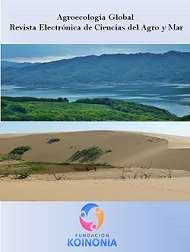Conservation of aloe (Aloe vera) and mango (Mangífera indica L) by honey syrup
Keywords:
Syrup, canned, mango, honey, aloe veraAbstract
The preservation of aloe (Aloe vera) and mango (Mangifera indica L) by means of a honey syrup", was carried out with the objective of determining the influence of honey on the physico-chemical characteristics of the conserve, the conserved was developed following a random statistical design of experiment with factorial arrangement A x B, where A represented the concentration of the syrup, and B the% of aloe and mango. Four treatments with three replications were established, using an ADEVA for the analysis of physico-chemical variables and Tukey to (p< 0,05) in the comparison of averages. The pH of the conserve had a value of 3.6 for the treatment A1 and 3.75 for the treatment A2, the best density was for the treatment was A1, with a value of 1.05 g / ml and 14.2ºBrix ( end). Regarding the acidity, the A1 treatment had an acidity average of 0.4117 of total acidity, and the B2 treatment, an average of 0.415 of total acidity, reflected the higher means, that is to say that in general, the best treatment was A1 B2 (Syrup diluted at 14 ° Brix + 25% aloe - 75% mango). The value of solids soluble reflected an average of 14.2 ° Brix which complies with what is stipulated in the Codex Standard for Canned Mangoes "CODEX STAN 159-1987. Physico-chemical analyzes indicated that factor A directly influenced all parameters evaluated and in the case of factor B influenced the acidity of the finished product.
Downloads
References
Agrocalidad. (2015). Víveros registrados. Obtenido de http://www.agrocalidad.gob.ec/wp-content/uploads/2015/viveros-registrados-haste-el-mes-defebrero2015.xlsx
Bosquez, E. (2012). Procesamiento térmico de frutas y hortalizas.» 118-119. México: Trillas.
Chiumarelli, M., Ferrari, C., Sarantópoulos, C., y Hubinger, M. (2011). Fresh Cut “Tommy Atkins” Mango Pre-treated with Citric Acid and Coated with Cassava (Manihot Esculenta Crantz) Starch or Sodium Alginate. Innovative Food Science & Emerging Technologies 12, (3):381-387.
Domínguez - Fernández, R., Arzate-Vázquez, I., Chanona-Pérez, J., Welti-Chanes, J., Alvarado-González, J., Cladrón-Domínguez, G., Garibay-Febles, V. & Gutiérrez-López, G. (2012). El del de Aloe vera: Estructura, Composición Química, Procesamiento, Actividad Biológica e Importancia en la Industria Farmacéutica y Alimentaria. Revista Mexicana de Ingeniería Química. 11(1), 23-43.
Fundación Hogares Juveniles Campesinos. (2002). Manual Agropecuario, Biblioteca de Campo. Bogotá: Palomino.
Isique Huaroma, J. (2014). Elaboración de Frutas en Almíbar. Perú: Marco EIRL.
NTE INEN 381. (1985). Conservas vegetales. Determinación de acidez titulable. Método potenciométrico de referencia. Quito: Primera Edición.
NTE INEN 380. (2008). Conservas vegetales. Determinación de sólidos solubles. Método refractométrico. Quito: First Edition.
NTE INEN 381. (1985). Conservas vegetales. Determinación de acidez titulable. Método potenciométrico de referencia. Quito: Primera Edición.
Norma del Codex para Mangos en Conserva “CODEX STAN 159-1987”. Disponible en: http://www.sagarpa.gob.mx/agronegocios/Lists/Instrumentos%20Tcnicos%20Normalizacin%20y%20Marcas%20Colecti/Attachments/58/CXS_159-1987_MANGOS_CONSERVA.pdf
Osorio, L. (2003). Procesos Industriales en frutas y hortalizas. Colombia: Grupo Latino LTDA.
Singh, Z., Singh, R., Sane, V. y Nath, P. (2013). Mango-Postharverst Biology and Biotechnology. Critical Reviews in Plant Sciences, 32 (4), 217-236.
Published
How to Cite
Issue
Section
License
CC BY-NC-SA : Esta licencia permite a los reutilizadores distribuir, remezclar, adaptar y construir sobre el material en cualquier medio o formato solo con fines no comerciales, y solo siempre y cuando se dé la atribución al creador. Si remezcla, adapta o construye sobre el material, debe licenciar el material modificado bajo términos idénticos.
OAI-PMH URL: https://fundacionkoinonia.com.ve/ojs/index.php/agroecologiaglobal/oai





.png)


